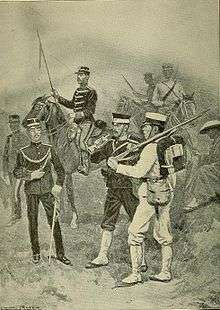Ernest Prater
Ernest Prater (1864–1950) was a noted English artist[1] and book illustrator, notable also for his work as a war correspondent and reportage artist during the Anglo-Boer War.

Life and works
Prater was born in Islington in London, of Cornish descent; his father was Joseph Prater of Crantock, Cornwall. He attended Dr. Devonshire's school in London, and began his working life as a publisher's clerk and took up drawing. His listing in Who's Who in Art for 1929 stated that his recreations included all rigorous sports.
He served for a period with the 3rd Middlesex Artillery.[2] He became a Boer War correspondent for The Sphere, attached to General Buller's column, sending back illustrations from the battlefield.[3] He also worked for the Black & White Budget and The Graphic newspapers.[4] As well as being an illustrator, he was an adept photographer.[5] He contributed illustrations to the Strand Magazine, Pall Mall Gazette and Boy's Own Paper and for books published by the Society for Promoting Christian Knowledge, the Religious Tract Society, Carey Press, Sheldon Press and others.
Prater specialised in illustrating boys' adventure stories. Among the well-known authors whose works he illustrated were G.A. Henty, R.M. Ballantyne, W.H.G. Kingston, Percy F. Westerman, Frank T. Bullen, Tom Bevan, Herbert Hayens and Bessie Marchant.
He was noted for his painting The Last Pass: A Thrilling Moment in a Rugby Match'.[6]
He also collaborated with Sidney Paget, the illustrator for the Sherlock Holmes books by Sir Arthur Conan Doyle. One such drawing was the funeral for Queen Victoria (location unknown).
In 1911 he was living at Newquay, The Leas, Westcliff in the parish of Prittlewell. His occupation is Artist Illustrator B and W. Living in the household are his wife Florence Alice Prater (née Norris) and their children Gladys Alma (11), Marie Lilian Marguerite (9), Minnie Winifred (6), Ruby Albina (3) and Raleigh Brandon (1).[7] He died in London on Sunday 11 June 1950, aged 86. A photograph of him appeared in The Sphere on 27 January 1900, and in The Year's Art in 1901.
References
- Bernard Dolman (Ed) Who's Who in Art, The Art Trade Press Ltd., 1927.
- Pat Hodgson, The War Illustrators, Macmillan, 1977, p.183
- Albert Charles Robinson Carter. The Work of War Artists in South Africa (Art Journal, London, 1900 - reprinted with annotations by Steve Lunderstedt, W. Humphreys Art Gallery, Kimberly, South Africa, 1999). ISBN 0-620-25198-0
- Ryno Greenwall, Artists and illustrators of the Anglo-Boer War, Fernwood Press, Vlaeberg, 1992. ISBN 0-9583154-2-6, ISBN 0-9583154-6-9
- John Gooch, The Boer War: Direction, Experience, and Image, Routledge, 2000, ISBN 0-7146-5101-X
- Derek Birley, Land of Sport and Glory: Sport and British Society, 1887-1910, International Studies in the History of Sport. 1995
- 1911 Census
Selected illustrated books
- Henty, G. A. The lost heir (Toronto: Copp, Clark, 1899).
- Lampen, Charles Dudley. Mirango the man-eater: a tale of Central Africa (London, Society for Promoting Christian Knowledge, 1899).
- Miller, J. Martin. Official history of the Russian-Japanese war (1904).
- Mathews, Basil Joseph. John Williams, the shipbuilder (London: Humphrey Milford, Oxford University Press, 1915).
- Padwick, C. E. Mackay of the Great Lake (London: H. Milford, Oxford University Press, 1917).
External links
- Work by E. Prater (Bridgeman Art library)
- Works by Ernest Prater at Project Gutenberg
- Works by Ernest Prater at Faded Page (Canada)
- Works by or about Ernest Prater at Internet Archive
- Books illustrated by Ernest Prater (WorldCat)